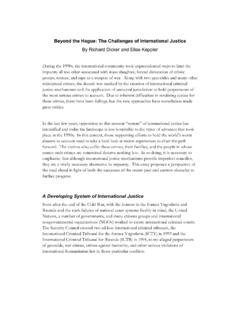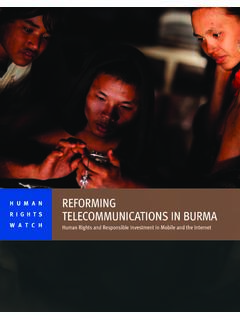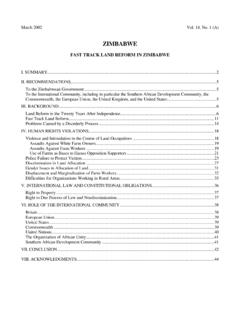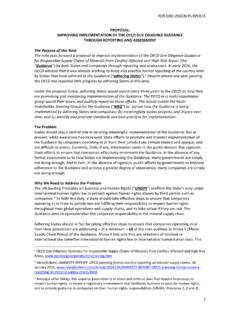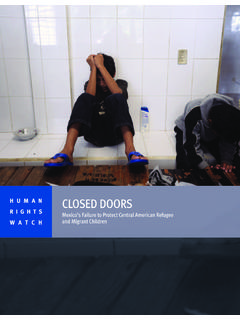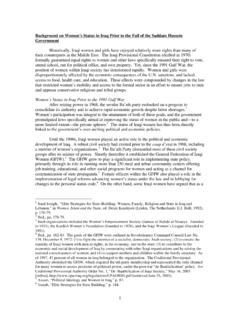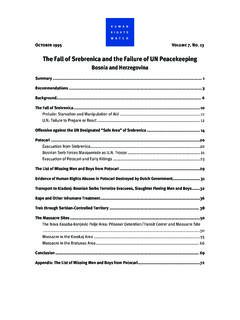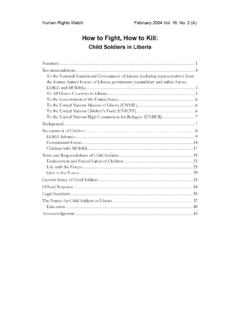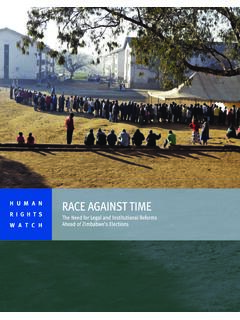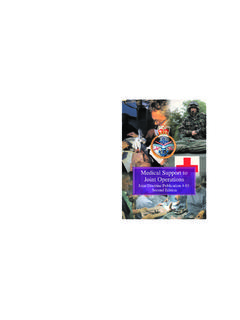Transcription of Joint Doctrine for Detainee Operations - hrw.org
1 Final Coordination23 March 2005 Joint Doctrine forDetainee OperationsJoint Publication 3-63 PREFACE i 1. Scope 1 2 This publication provides guidelines for planning and executing Detainee Operations . It 3 outlines responsibilities and discusses organizational options, and command and control 4 considerations across the range of military Operations . 5 6 2. Purpose 7 8 This publication has been prepared under the direction of the Chairman of the Joint Chiefs of 9 Staff. It sets forth Joint Doctrine to govern the activities and performance of the Armed Forces of 10 the United States in Operations and provides the doctrinal basis for interagency coordination and 11 for US military involvement in multinational Operations . It provides military guidance for the 12 exercise of authority by combatant commanders and other Joint force commanders (JFCs) and 13 prescribes Joint Doctrine for Operations and training.
2 It provides military guidance for use by the 14 Armed Forces in preparing their appropriate plans. It is not the intent of this publication to 15 restrict the authority of the JFC from organizing the force and executing the mission in a manner 16 the JFC deems most appropriate to ensure unity of effort in the accomplishment of the overall 17 objective. 18 19 20 Preface ii JP 3-63 3. Application 1 2 a. Joint Doctrine established in this publication applies to the commanders of combatant 3 commands, subunified commands, Joint task forces, subordinate components of these commands, 4 and the Services.
3 5 6 b. The guidance in this publication is authoritative; as such, this Doctrine will be followed 7 except when, in the judgment of the commander, exceptional circumstances dictate otherwise. If 8 conflicts arise between the contents of this publication and the contents of Service publications, 9 this publication will take precedence unless the Chairman of the Joint Chiefs of Staff, normally in 10 coordination with the other members of the Joint Chiefs of Staff, has provided more current and 11 specific guidance. Commanders of forces operating as part of a multinational (alliance or 12 coalition) military command should follow multinational Doctrine and procedures ratified by the 13 United States. For Doctrine and procedures not ratified by the United States, commanders should 14 evaluate and follow the multinational command s Doctrine and procedures, where applicable and 15 consistent with US law, regulations, and Doctrine .
4 16 17 18 For the Chairman of the Joint Chiefs of Staff: 19 20 21 22 23 NORTON A. SCHWARTZ 24 Lieutenant General, USAF 25 Director, Joint Staff 26 27 28 TABLE OF CONTENTS iii PAGE 1 2 EXECUTIVE ix 3 4 CHAPTER I 5 INTRODUCTION 6 7 Background .. I-1 8 Purpose .. I-2 9 Policy .. I-2 10 Legal Considerations .. I-5 11 Detainee Classification .. I-8 12 13 CHAPTER II 14 PLANNING AND TRAINING FOR Detainee Operations 15 16 Introduction .. II-1 17 Detainee Operations Planning .. II-11 18 Internment Serial Numbers .. II-14 19 Operational Considerations .. II-17 20 Detainee Control and Discipline .. II-26 21 Table of Contents iv JP 3-63 Protection of detainees .
5 II-27 1 Use of Force .. II-28 2 Training for Detainee Operations .. II-32 3 4 CHAPTER III 5 ROLES AND RESPONSIBILITIES 6 7 Secretary of Defense .. III-1 8 Secretaries of the Army, Navy, and Air Force .. III-2 9 Chairman of the Joint Chiefs of Staff .. III-2 10 Combatant Commanders .. III-2 11 Subordinate Joint Force Commanders .. III-3 12 Functional/Service Component Commanders .. III-3 13 Chief, Detainee Operations .. III-4 14 Detention Facility Commander .. III-4 15 Joint Interrogation and Debriefing Center Commander .. III-5 16 Intelligence Analysts, Human Intelligence Collectors, Interpreters, and Translators .. III-5 17 Joint Force Intelligence Directorate Counterintelligence and Human Intelligence 18 Staff Element Officer and Collection Manager .. III-8 19 Civil Affairs Officers .. III-8 20 Medical Officer/Surgeon.
6 III-9 21 Staff Judge Advocate/Legal Advisor .. III-11 22 Table of Contents v Chaplain .. III-11 1 Engineer .. III-12 2 Interagency Representatives .. III-13 3 Multinational/Allied Representatives .. III-13 4 Inspector General .. III-13 5 6 CHAPTER IV 7 CAPTURE AND INITIAL DETENTION AND SCREENING 8 9 Background .. IV-1 10 Principles of Detention and Screening .. IV-2 11 Procedures .. IV-11 12 13 CHAPTER V 14 TRANSPORT PROCEDURES 15 16 Background .. V-1 17 Procedures .. V-2 18 In-transit Operations for Escort Missions .. V-2 19 Detainee Movement by Land Transportation .. V-3 20 Detainee Movement by Maritime Transportation .. V-3 21 Detainee Movement by Air .. V-4 22 Table of Contents vi JP 3-63 1 CHAPTER VI 2 LONG TERM DETENTION 3 4 General.
7 VI-1 5 Background .. VI-1 6 Organization .. VI-2 7 Facility Operations .. VI-3 8 Reception of detainees .. VI-4 9 10 CHAPTER VII 11 TRANSFER OR RELEASE FROM DETENTION 12 13 General .. VII-1 14 Background .. VII-4 15 Review and Approval Process .. VII-4 16 Transfer to Established Recognized National Authority, Allied Facilities, or 17 Inter-Service Agencies .. VII-5 18 Transfer Between Department of Defense Facilities .. VII-6 19 Transfer or Release Mission .. VII-8 20 21 22 Table of Contents vii APPENDIX 1 2 A Riot Control Measures .. A-1 3 B Detention of Enemy Combatants at Military Confinement Facilities .. B-1 4 C Detainee Reporting System .. C-1 5 D References .. D-1 6 E Administrative Instructions .. E-1 7 8 GLOSSARY 9 10 Part I Abbreviations and Acronyms.
8 GL-1 11 Part II Terms and Definitions .. GL-6 12 13 FIGURE 14 15 II-1 Command and Control Within the Joint Operations Area .. II-3 16 II-2 Holding Area (Camp Bucca, OIF) .. II-17 17 II-3 Clothing Issue .. II-19 18 II-4 Use of Force Continuum .. II-32 19 IV-1 Detainee Initial Collection Point .. IV-3 20 IV-2 Detainee Holding Area .. IV-5 21 IV-3 Detainee Flow Diagram .. IV-7 22 VII-1 Transfer Accountability Measures .. VII-10 23 Table of Contents viii JP 3-63 1 2 3 4 5 6 7 8 9 10 11 Intentionally Blank 12 13 EXECUTIVE SUMMARYCOMMANDER S OVERVIEW ixTo be SummaryJP 3-63 Intentionally Blank CHAPTER I INTRODUCTION I-1 American personnel are required to comply with all US laws, including the United 1 States Constitution, Federal statutes, including statutes prohibiting torture, and our 2 treaty obligations with respect to the treatment of all detainees .
9 The United States also 3 remains steadfastly committed to upholding the Geneva Conventions, which have 4 been the bedrock of protection in armed conflict for more than 50 years. These 5 Conventions provide important protections designed to reduce human suffering in 6 armed conflict. We expect other nations to treat our service members and civilians in 7 accordance with the Geneva Conventions. Our Armed Forces are committed to 8 complying with them and to holding accountable those in our military who do not. 9 10 President George W. Bush 11 12 1. Background 13 14 During the course of military Operations , members of the United States armed forces must 15 be prepared to detain personnel who are no longer willing or able to continue fighting, and other 16 personnel based on established detention criteria (threat to US forces; threat to members of the 17 local population; other security interests).
10 During the course of current and future Operations , 18 US forces are likely to encounter additional categories of both traditional and non-traditional 19 combatants (terrorists, insurgents, criminals). Following the events of September 11, 2001, a 20 new category of Detainee , enemy combatant (EC), was created for personnel who are not granted 21 or entitled to the privileges of the Geneva Convention. US forces must be prepared to take into 22 custody, maintain, protect, and account for all categories of potential detainees . It is imperative 23 Chapter I I-2 JP 3-63 that all individuals detained by US forces are treated in accordance with applicable domestic and 1 international law, and national policy.
